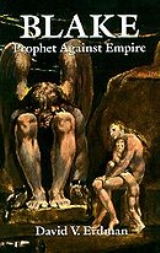
Blake: Prophet Against Empire
Encyclopedia
Blake: Prophet Against Empire: A Poet's Interpretation of the History of His Own Times is a 1954 biographical book by David V. Erdman
whose subject is the life and work of English
poet and painter William Blake
. Northrop Frye
has described the book as a work full of knowledge of the meaning of Blake's Prophecies
and the first to make a consistent use of the primary source
s of historical scholarship. The book tries to re-tell the social history of England as seen through Blake's eyes starting with the peaceful years of the 1760s, which Blake regarded, in his childhood, as time of innocence. Then moving forward to all the major events such as the American Revolution
, the Gordon riots
, the French Revolution
, the policies of the Pitt
government and the famine
in England. Erdman explains that Blake was far from being an abstract
or vague poet, but a concrete
one whose social environment
helped shape both his most famous and obscure works.
David V. Erdman
David V. Erdman was an American literary critic, editor, and Professor Emeritus of English at the State University of New York at Stony Brook. Professor Erdman established his reputation as a William Blake scholar when his Blake: Prophet Against Empire was published in 1954...
whose subject is the life and work of English
English people
The English are a nation and ethnic group native to England, who speak English. The English identity is of early mediaeval origin, when they were known in Old English as the Anglecynn. England is now a country of the United Kingdom, and the majority of English people in England are British Citizens...
poet and painter William Blake
William Blake
William Blake was an English poet, painter, and printmaker. Largely unrecognised during his lifetime, Blake is now considered a seminal figure in the history of both the poetry and visual arts of the Romantic Age...
. Northrop Frye
Northrop Frye
Herman Northrop Frye, was a Canadian literary critic and literary theorist, considered one of the most influential of the 20th century....
has described the book as a work full of knowledge of the meaning of Blake's Prophecies
William Blake's prophetic books
The prophetic books of the English poet and artist William Blake are a series of difficult and obscure poetic works. While Blake worked as a commercial illustrator, these books were ones that he produced, with his own engravings, as an extended and largely private project...
and the first to make a consistent use of the primary source
Primary source
Primary source is a term used in a number of disciplines to describe source material that is closest to the person, information, period, or idea being studied....
s of historical scholarship. The book tries to re-tell the social history of England as seen through Blake's eyes starting with the peaceful years of the 1760s, which Blake regarded, in his childhood, as time of innocence. Then moving forward to all the major events such as the American Revolution
American Revolution
The American Revolution was the political upheaval during the last half of the 18th century in which thirteen colonies in North America joined together to break free from the British Empire, combining to become the United States of America...
, the Gordon riots
Gordon Riots
The Gordon Riots of 1780 were an anti-Catholic protest against the Papists Act 1778.The Popery Act 1698 had imposed a number of penalties and disabilities on Roman Catholics in England; the 1778 act eliminated some of these. An initial peaceful protest led on to widespread rioting and looting and...
, the French Revolution
French Revolution
The French Revolution , sometimes distinguished as the 'Great French Revolution' , was a period of radical social and political upheaval in France and Europe. The absolute monarchy that had ruled France for centuries collapsed in three years...
, the policies of the Pitt
William Pitt, 1st Earl of Chatham
William Pitt, 1st Earl of Chatham PC was a British Whig statesman who led Britain during the Seven Years' War...
government and the famine
Famine
A famine is a widespread scarcity of food, caused by several factors including crop failure, overpopulation, or government policies. This phenomenon is usually accompanied or followed by regional malnutrition, starvation, epidemic, and increased mortality. Every continent in the world has...
in England. Erdman explains that Blake was far from being an abstract
Abstract art
Abstract art uses a visual language of form, color and line to create a composition which may exist with a degree of independence from visual references in the world. Western art had been, from the Renaissance up to the middle of the 19th century, underpinned by the logic of perspective and an...
or vague poet, but a concrete
Concrete
Concrete is a composite construction material, composed of cement and other cementitious materials such as fly ash and slag cement, aggregate , water and chemical admixtures.The word concrete comes from the Latin word...
one whose social environment
Social environment
The social environment of an individual, also called social context or milieu, is the culture that s/he was educated or lives in, and the people and institutions with whom the person interacts....
helped shape both his most famous and obscure works.
External links
- Blake: Prophet Against Empire: A Poet's Interpretation of the History of His Own Times Limited view book on Google Books

